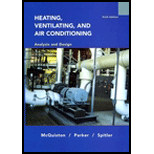
Work Problem 4-24 but replace the 100 percent outdoor air requirement with 25 percent outdoor air and use high-performance filters for the return air. Gravimetric efflciency must be at least 99 percent in the
Want to see the full answer?
Check out a sample textbook solution
Chapter 4 Solutions
Heating Ventilating and Air Conditioning: Analysis and Design
Additional Engineering Textbook Solutions
Mechanics of Materials, 7th Edition
Applied Statics and Strength of Materials (6th Edition)
Fluid Mechanics Fundamentals And Applications
Engineering Mechanics: Statics & Dynamics (14th Edition)
Fundamentals Of Thermodynamics
Manufacturing Engineering & Technology
- The moisture removed from a material is 200 lb/hr and change of humidity ratio of air in the dryer is 105 grains/lbmd.a. Determine the fan capacity in cfm if specific volume of air entering is 38 ft3 /lb.arrow_forwardAn ammonia compressor has a 5 percent clearance volume and a displacement rate of 80'L/s and pumps against a condensing temperature of 40 C. For the two different evaporating temperatures of -10 and 10 C, compute the refrigerant flow rate assuming that the clearance volumetric efficiency applies.arrow_forward4. Air at 25 °C and 50 % of RH flows over a water surface measuring 12 m x 6 m at a velocity of 2 m/s. Determine the water loss per day considering flow direction is along the 12 m side. Notes: i. For air; p =1.12 kg/m', c, = 1005 J/kgK, k = 0.026 W/mK, Pr =0.7, v = 15x10“ m/s, For air-water mixture; DH20-air = 24x10° m²/s. ii. For water; T T 2.325 2 Psat@rc = 0.782 + 2.962 100 + 6.29 100arrow_forward
- he night-time chilled water system is not a closed loop system, meaning that some amount of water is lost due to evaporation every night. If it is 96% efficient (i.e. 4% of the water flow rate is dispersed to the outdoor air and needs to be replaced), how much make up water does it need to draw from the municipal water supply daily (in gallons)? Round to nearest integer. (Given: Qheat loss = 1,500,000 Btu) Total gallons in water tank: 1500 gallons//system runs: 10 hoursarrow_forwardA batch centrifugal filter having a bowl diameter of 750 mm and a bowl height of 450 mm is used to filter a suspension having the following properties: Liquid, water Temperature, 25°C Concentration of solid in feed, 60 g/L Porosity of cake, 0.835 Density of dry solid in cake, 2000 kg/m' Final thickness of cake, 150 mm Speed of centrifuge, 2000 r/min Specific cake resistance, 9.5 x 1010 ftflb Filter medium resistance, 2.6 x 101Oft-l The final cake is washed with water under such conditions that the radius of the inner surface of the liquid is 200 mm. Assuming that the rate of flow of wash water equals the final rate of flow of filtrate, what is the rate of washing in cubic meters per hour?arrow_forward• Water evaporates from the surface of a pond and the vapour diffuses through the stagnant film of air of thickness 3 mm. Water temperature is 23°C and the air temperature is 27°C. Relative humidity of air is 65%. Average diffusivity is 0.2595 cm²/s. What is the average flux of evaporation? Antoine equation constants A=13.8573 B=5160.2arrow_forward
- Q/ Air is to be bubbled through the solution in the reactor CSTR, in order to strip out of the solution trace amounts of a solvent that have contaminated the water. The rate of loss of the solvent from the solution can be characterized by the equation r = -0.03/min c, where c is the solvent concentration. What fraction of the solvent will be removed from the water as it passes through the reactor with residence time is 26.4 min.arrow_forwardCalculate the heat transfer Coefficient for hydrogen flowing through a 84.480mm Velochy of 1.95 m/s. Bore with a Average temp is 1200 °C ?arrow_forwardUsing the data of Problem 6.1 design a shaker baghouae to filter 2000 m3/min of air that contains 1.50 g/m3 of limestone dust Assume that the cleaning time for one compartment is 3.0 minutes and that the available ∆Pm is 2000 Pa, In your design, specify the filtering velocity, the number of compartments, the cloth area per compartment, and the filtration time tf.arrow_forward
- H-w A 120 resistor has aspecified maximum fampower dissipation.af Aw. Calculate the maximumcurrent level.arrow_forwardpure water at 20 c is flowing down an inclined wetted - wall ( making an angle of 60 with horizontal ) at rate of 0.124kg/s.m calculate the film thickness then using a shell momentum balance . calculate the average velocityarrow_forwardHVAC UPVOTE WILL BE GIVEN. ANSWERS ARE GIVEN ALREADY. PLEASE WRITE THE COMPLETE SOLUTIONS. Air with dry bulb temperature of 25°C (Psat=3.169 kPa) and a wet bulb temperature of 15°C (Psat = 1.7051 kPa) flows in round duct of diameter 800 m/s with a velocity of 7 m/s. Defermine a) RH (Ans. 33%) b) Moisture content (Ans. 00065) c) Sp. Enthalpy (Ans. 42) d) Mass Flow rate (Ans. 249 kg/min) e) Mass Flow rate of dry air (Ans. 247 kg/min) f) DPT (Ans. 8°C) 9) Sp. volume (Ans. 0.85)arrow_forward
 Principles of Heat Transfer (Activate Learning wi...Mechanical EngineeringISBN:9781305387102Author:Kreith, Frank; Manglik, Raj M.Publisher:Cengage Learning
Principles of Heat Transfer (Activate Learning wi...Mechanical EngineeringISBN:9781305387102Author:Kreith, Frank; Manglik, Raj M.Publisher:Cengage Learning
